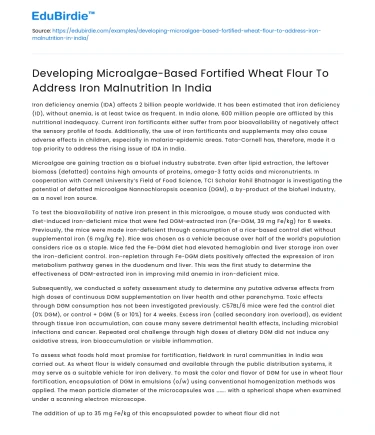Iron deficiency anemia (IDA) affects 2 billion people worldwide. It has been estimated that iron deficiency (ID), without anemia, is at least twice as frequent. In India alone, 600 million people are afflicted by this nutritional inadequacy. Current iron fortificants either suffer from poor bioavailability of negatively affect the sensory profile of foods. Additionally, the use of iron fortificants and supplements may also cause adverse effects in children, especially in malaria-epidemic areas. Tata-Cornell has, therefore, made it a top priority to address the rising issue of IDA in India.
Microalgae are gaining traction as a biofuel industry substrate. Even after lipid extraction, the leftover biomass (defatted) contains high amounts of proteins, omega-3 fatty acids and micronutrients. In cooperation with Cornell University’s Field of Food Science, TCI Scholar Rohil Bhatnagar is investigating the potential of defatted microalgae Nannochloropsis oceanica (DGM), a by-product of the biofuel industry, as a novel iron source.
Save your time!
We can take care of your essay
- Proper editing and formatting
- Free revision, title page, and bibliography
- Flexible prices and money-back guarantee
To test the bioavailability of native iron present in this microalgae, a mouse study was conducted with diet-induced iron-deficient mice that were fed DGM-extracted iron (Fe-DGM, 39 mg Fe/kg) for 6 weeks. Previously, the mice were made iron-deficient through consumption of a rice-based control diet without supplemental iron (6 mg/kg Fe). Rice was chosen as a vehicle because over half of the world’s population considers rice as a staple. Mice fed the Fe-DGM diet had elevated hemoglobin and liver storage iron over the iron-deficient control. Iron-repletion through Fe-DGM diets positively affected the expression of iron metabolism pathway genes in the duodenum and liver. This was the first study to determine the effectiveness of DGM-extracted iron in improving mild anemia in iron-deficient mice.
Subsequently, we conducted a safety assessment study to determine any putative adverse effects from high doses of continuous DGM supplementation on liver health and other parenchyma. Toxic effects through DGM consumption has not been investigated previously. C57BL/6 mice were fed the control diet (0% DGM), or control + DGM (5 or 10%) for 4 weeks. Excess iron (called secondary iron overload), as evident through tissue iron accumulation, can cause many severe detrimental health effects, including microbial infections and cancer. Repeated oral challenge through high doses of dietary DGM did not induce any oxidative stress, iron bioaccumulation or visible inflammation.
To assess what foods hold most promise for fortification, fieldwork in rural communities in India was carried out. As wheat flour is widely consumed and available through the public distribution systems, it may serve as a suitable vehicle for iron delivery. To mask the color and flavor of DGM for use in wheat flour fortification, encapsulation of DGM in emulsions (o/w) using conventional homogenization methods was applied. The mean particle diameter of the microcapsules was …….. with a spherical shape when examined under a scanning electron microscope.
The addition of up to 35 mg Fe/kg of this encapsulated powder to wheat flour did not cause any stability changes for 45 days, as measured through lipid peroxidation, color change and moisture content. In fact, the encapsulation process prevented the oxidation of ferrous ions present in the DGM to ferric ions. We also conducted a sensory analysis (n = 110) with Indian baked bread (chapatis) made from wheat flour supplemented with encapsulated DGM at a 35 mg Fe/kg fortification rate, and concluded that there was significant differences between fortified or unfortified chapatis. The work presented in this dissertation provides a novel approach to combat global iron malnutrition, and exhibits the vast potential of DGM as an effective and safe iron source.






 Stuck on your essay?
Stuck on your essay?

